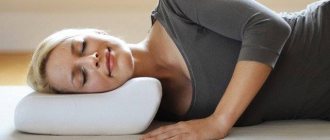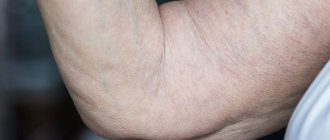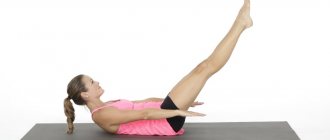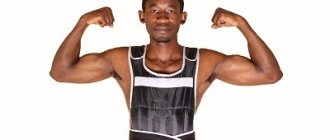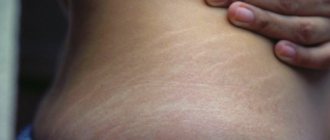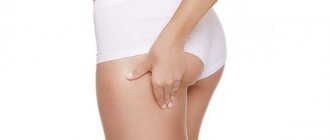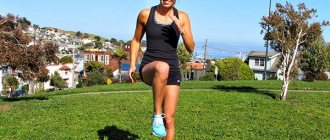Why do stretch marks occur?
Stretch marks are a skin defect in the form of pink and red stripes. Most often, the problem occurs in areas of the body that are subject to maximum stretching. Striae are microtraumas of individual skin fibers. They occur when the epidermis is significantly stretched. In this case, stretch marks do not pose any health hazard, but are only a cosmetic defect. The area where the problem is localized is the chest, abdomen, hips, buttocks and legs. Striae occur for various reasons.
The main provoking factors for the appearance of stretch marks on the hips, legs and buttocks:
- sudden weight gain;
- reduced elasticity of epidermal fibers (genetic feature);
- active sports, namely squats;
- lack of skin hydration, dryness;
- hormonal disorders.
An important cause of stretch marks is reduced elasticity of the epidermis. So, one woman may have stretch marks even with a slight weight gain, while another woman may not develop stretch marks even with a strong increase in body weight. Most often, stretch marks occur during pregnancy, adolescence, and also when the production of the hormone cortisol by the adrenal glands is disrupted.
Striae on the thighs occur due to various provoking factors
In rare cases, not vertical, but horizontal striae may occur. This indicates the presence of serious endocrine disorders.
Leg stretching exercises on the floor
The selection includes leg stretching exercises that help get rid of muscle tightness, tension, stress, and improve flexibility and balance. They are suitable for relaxation at home or for a full stretching workout. Many exercises are aimed at stretching the adductor muscles, which will help you master the transverse and longitudinal splits.
Pigeon pose
What we stretch: Buttocks, hamstrings.
How to do it: Lower into a low lunge with your right foot forward. Touch your right knee to the floor so that your ankle is on the floor and your shin is perpendicular to your thigh. The left leg should be straight, relaxed, resting on the instep of the foot. For greater effect, bend your forearms and lean on them. Hold the pose for half a minute and repeat the process on the other side. This yoga pose has a more advanced variation, such as grabbing the shin of the back leg for extreme stretching of the legs.
Modification for beginners: Do not move your front foot away from you, do not lower your pelvis too low to the floor.
Pigeon pose with shin grip
What we stretch: Quadriceps, hamstrings.
How to do it: From pigeon pose (previous exercise), pull the shin of your right leg towards your thigh. Raise your left leg, holding it with your left hand by the shin or foot. Pull the foot of your left leg as close to your thigh as possible, stretching the muscles. After half a minute, change legs.
Modification for beginners: Perform the exercise at a comfortable range of motion, without sitting too deep in pigeon pose or raising your shin too high.
Sitting pigeon pose
What we stretch: Buttock muscles.
How to do it: Sit on the floor with your legs extended straight. Bend your left leg at the knee and pull your shin as close to you as possible. Don't round your back, stretch your gluteal muscles. Hold the exercise for half a minute and change legs.
Modification for beginners: Do not lift your shin high - you can put it on the thigh of your leg, which lies on the floor.
Lying quadriceps stretch
What we stretch: Quadriceps.
How to do it: Lie on your stomach, rest your head on your palm. Bend your left leg at the knee and grab your shin with your left hand. Pull your foot towards you without lifting your thigh off the floor, and try to touch your buttock with your foot. Hold the pose for half a minute, repeat on the other side.
Modification for beginners: Pull your foot toward your buttocks until you feel comfortable and have a slight stretch in your quadriceps.
How to choose sneakers for fitness
Bend to the leg while kneeling
What we're stretching: Hamstrings.
How to do it: Kneeling, extend your right leg forward. Bend your entire body toward your right leg, stretching the back of your thighs. You can place your hands on the floor or wrap them around your feet if the stretch allows. Advanced people can lower their buttocks onto the thigh of their left leg. Do this leg stretching exercise for half a minute, then switch sides. Bend to the leg while kneeling is one of the best exercises for longitudinal splits.
Modification for beginners: Do not lower your body low, keep your back straight.
Tilt to straight legs while sitting
What we're stretching: Hamstrings.
How to do it: In a sitting position, straighten your legs. Bend towards your knees, trying not to arch your spine. Stretch your hands towards your feet, do not round your back. Hold the pose for half a minute.
Modification for beginners: You can bend your knees a little, but so as to feel the stretching of the hamstrings.
Tilt to leg while sitting
What we're stretching: Hamstrings.
How to do it: From a sitting position, extend your right leg, bend your left leg at the knee and place your shin on the floor. Move your right leg a little to the side, leave your left in its original position. Stretch your entire body toward your straightened right leg, stretching the back of your thigh. Hold the pose for half a minute and repeat on the other side.
Modification for beginners: Don't lower your body too low to your leg.
Seated split bend
What we stretch: Hip adductors, hamstrings.
How to do it: From a sitting position, spread your legs to the sides. Lean forward without arching your spine. You can lean on the floor with your forearms or palms, or lie completely on the floor if stretching allows. Hold the pose for half a minute. A modification of the exercise is bending over to each leg in a split; they additionally engage the back of the thighs.
Modification for beginners: Do not spread your legs wide and do not bend your body down too much; you can rest the inside of your feet on the legs of a table or bed for a more comfortable stretch.
Butterfly pose
What we stretch: Adductor muscles of the thighs.
How to do it: Sitting on the floor, bend your knees, feet facing each other. Close your feet and press your hands onto your knees to increase the stretch. Don't arch your back, look forward. You should not put too much pressure on your knees to avoid discomfort and pain. Stay in the pose for half a minute. You can do a seated butterfly against a wall to make it easier to keep your back straight.
Modification for beginners: If there is not enough stretching, do not lower your knees too low to the floor, you can move your feet further away from the pelvis.
Back Butterfly Pose
What we stretch: Adductor muscles of the thighs.
How to do it: Lie on your back, bend and spread your knees, pointing your feet inward. Close the feet of both legs, forming a butterfly pose on your back. Try to touch your hips and knees to the floor. Help yourself with your hands, but do not put too much pressure on your knees to avoid injury. Perform the thigh stretching exercise for half a minute.
Modification for beginners: Do not lower your knees low to the floor; your feet can be moved further away from the pelvis.
Frog pose
What we stretch: Hip adductors, quadriceps, gluteus maximus.
How to do it: From a lying position on your stomach, spread your bent knees to the sides. The pose should resemble a frog. Keep your knees at right angles. Try to touch the floor with your pelvis. Hold the exercise for half a minute. An excellent yoga hip stretch that relaxes all the pelvic muscles and relieves tightness and tension in the lower back and hips.
Modification for beginners: Do not spread your legs too far apart; place a towel or soft mat under your knees.
Hip stretch while sitting on your heels
What we stretch: Quadriceps.
How to do it: From a kneeling position, sit on your heels and lean on your elbows. Feel the quadriceps stretch. This is one of the best exercises to stretch the quadriceps muscles. However, if you experience severe discomfort in your knees or back when doing this leg stretching exercise, then it is better to replace it with another exercise.
Modification for beginners: Don't go too low, leaning not on your forearms, but on your arms extended back.
Lying longitudinal split
What we're stretching: Hamstrings.
How to do it: Lie on your back and lift your left leg straight up. Grab your shin with your hands and pull your leg towards you. Do not lift your right leg and lower back off the floor. To make stretching more comfortable, take an elastic band or towel and place it over your foot to pull your leg up without using your hands. Hold the position for half a minute, then switch legs.
Modification for beginners: Bend your knee on the floor, but do not lift your leg too high.
Taking the leg to the side
What we stretch: Adductor muscles, buttocks.
How to do it: Lie on your back and move your left straight leg to the side. Grab your shin or foot with your hands and pull your leg toward you and to the side. Feel the stretch in your leg muscles. You can also use a towel to stretch your legs in this exercise. Do not lift your right leg and lower back off the floor. Hold the position for half a minute, then switch legs. This and the previous exercises are perfect for practicing splits.
Modification for beginners: Bend your knee on the floor, but do not move your leg too far to the side.
Lying cross split
What we stretch: Adductor muscles of the thighs.
How to do it: Lie on your back and lift both legs up. Begin to slowly spread your legs, as if doing a cross split. Help yourself with your hands, but do not put too much pressure on your legs so as not to pull the muscles. There is a modification of this exercise for the thigh wall stretch. In this case, you need to lie close to the wall and spread your legs so that they slide along its surface. In this case, it will be easier to maintain balance and concentrate on stretching.
Modification for beginners: Perform the exercise against a wall and do not spread your legs too far.
Lying buttock stretch
What we stretch: Gluteus maximus muscles.
How to do it: From a supine position, bend your knees. Place the shin of your left leg on the thigh of your right. Grab your right leg with both hands and pull it towards you to give your gluteal muscles a good stretch. Hold the exercise for half a minute and repeat on the other side.
Modification for beginners: You can slightly lift your head and upper back off the floor
Pulling the knee to the chest
What we stretch: Hamstrings, glutes.
How to do it: From a lying position, lift your bent right leg and pull your knee toward your chest with both hands. Feel a gentle stretch in your glutes and hamstrings. Hold the pose for half a minute, then repeat on the other side. This is a great exercise not only for stretching your legs, but also for relaxation before bed.
Modification for beginners: Bend your knees with your leg on the floor.
Types of striae
Depending on the stage of development, there are several types of stretch marks:
- Red - occur at the initial stage, immediately after microfracture of the fibers. They have a bright color and are often deep. Their width can vary from a few millimeters to 0.5 cm.
- Pink ones are, as a rule, not very fresh stretch marks. Unlike the initial stage, they are paler and less noticeable.
- White - characterize the last stage of development. In this case, the stretch marks become light and unnoticeable. However, small depressions remain.
The skin in the area of stretch marks is very sensitive to any irritant. Even if you overdo it with massage, you can aggravate the symptoms.
Occupational therapy
The pharmaceutical and cosmetic industry cannot offer an ideal remedy that would instantly solve the problem of stretch marks on the legs. There are some effective manipulations, which are confirmed by positive reviews from patients. After their use, patients experience significant improvements or complete disappearance of atrophy areas.
Professional methods for removing stretch marks include:
- Laser therapy - under the influence of fractional rays, stretch marks become less noticeable, some of them disappear without a trace. The maximum result is achieved with a full course of treatment. The number of manipulations depends on the condition of the skin, the level of damage, and the type of dermis.
- Cosmetics - many manufacturers offer their own options for combating stretch marks, using a variety of ointments, creams or gels. Dermatologists advise using medications in the initial stages of development of an abnormal condition or as a means of preventive action.
- Mesotherapy is one of the most common and widely used techniques. During the manipulation process, the specialist prepares a mixture of medicinal substances and introduces them into the thickness of the dermis using a specialized roller with the maximum number of needles. The technique allows you to restore the process of collagen and elastin production in areas where the integrity of the skin tissue is damaged.
- Surgical interventions - cosmetic surgeries are prescribed for patients with sagging skin and large areas of stretch marks. During the procedure, parts of the problematic dermis, part of the stretch marks and subcutaneous fat are excised.
- Chemical peeling - problem areas of the skin are treated with acid solutions, causing damage and subsequent necrosis. The postoperative period is characterized by healing and increased reproduction of healthy cellular structures. Side effects from this technique are pigmentation of the dermis and possible formation of scars.
Laser therapy
Cosmetical tools
Mesotherapy
Chemical peeling
How to get rid of stretch marks in the buttocks, thighs and legs
As practice shows, dealing with fresh stretch marks is much easier than with old ones. If stretch marks have been present on the body for a long time, then getting rid of them forever will be problematic. In a beauty salon, chemical peeling is often used, which gives good results. Due to the aggressive effects of acids, the epidermis burns. This stimulates the production of your own collagen fibers. As a result, the skin is renewed.
Additionally, a laser is used. Today this method is one of the most effective. The procedure is performed under local anesthesia. Using a laser, the affected areas are cauterized, resulting in a crust that then falls off. In its place, healthy and aesthetically attractive skin remains.
If you combine peeling and procedures aimed at moisturizing the epidermis in the stretch mark area, then even old stretch marks can be made less pronounced. To do this, you should combine several means. First you need to eliminate dead skin particles using peeling, gently massaging the problem area. Then use any moisturizer.
Home methods
The most effective home remedies for getting rid of stretch marks are the following:
- Regenerating infusion. You will need 2 tbsp chamomile flowers. l. The raw materials need to be poured with hot milk and left for several hours. Then filter and soak a piece of cotton cloth in the liquid and apply to the problem area for 20 minutes. This procedure should be carried out 3 times a week for a month.
- Olive oil. Additionally you will need almond. Both types of oils should be taken in the amount of 1 tsp. and mix until a homogeneous mixture is obtained. Rub the resulting mixture every day before bed after a shower into the stretch marks area. Duration of treatment is 1 month or more.
- Coconut and almond oils. They need to be mixed in equal proportions and applied daily with massaging movements to the stretch mark area. Use for at least a month.
- Coffee. You will need steamed cake. They need to massage the stretch marks. This simple peeling perfectly stimulates regeneration processes, and coffee has an antioxidant effect. The procedure must be carried out 2 times a week for a month.
- Mumiyo. You can prepare a universal remedy for all types of stretch marks. To do this, you will need 1 tablet of mumiyo, which must be crushed and dissolved in 1 tbsp. l. water. Then add the same amount of baby cream and mix everything thoroughly. Apply the resulting composition once a day with massaging movements. The course of treatment is a month.
The best home remedies for effective exfoliation are coffee and sea salt. During the procedures, you should not put too much pressure on the problem area. This way you can damage the thin skin in the area of stretch marks.
Photo gallery: useful components in the complex for getting rid of stretch marks
Chamomile with milk has excellent healing properties
Olive oil stimulates regeneration processes
Coconut oil speeds up the healing of stretch marks
Ground coffee is an excellent scrub
Mumiyo is the best remedy for stretch marks
Baby cream is considered an excellent base for essential oils
Treating imperfections with massage
Treatment of stretch marks on the hips, buttocks and legs can be supplemented with massage. This approach is very effective if you follow all the rules:
- Perform the procedure daily after taking a bath or shower.
- During the massage, use oils for stretch marks - almond, olive or coconut.
- Do not do rough pinching manipulations.
- The massage should be more like intense stroking and patting of the problem area.
- The action must be performed for at least 5–7 minutes.
The course of procedures must be at least 10 days. Then you need to take a break and repeat. It is very effective to add rosemary essential oil to base formulations. It allows you to get rid of various types of stretch marks in a short time.
If you have stretch marks, it is better to avoid cupping massage and other types of vacuum treatment. Otherwise, you can only increase the severity of stretch marks. After all, during the procedure microtrauma of the skin occurs.
Exercises for stretching legs while standing
After working out in the gym, the best option would be standing leg stretching exercises. Some of them are suitable as a light warm-up between exercises, but in this case you should not stay in each pose for a long time, so as not to relax the muscles.
Low lunge
What we stretch: Quadriceps, hamstrings.
How to do it: Lower your right knee to the floor, straightening your leg. The left leg should be bent at a right angle and stand in front. Place your straight arms symmetrically on the floor or on the thigh of your front leg. Lower your pelvis lower, stretching the muscles of each leg. Hold the pose for half a minute, then change legs. This is one of the best leg stretching exercises and can be done in different variations. Throughout the exercise, pull your pelvis towards the floor, this will help to further stretch the thigh muscles of each leg.
Modification for beginners: Do not move your back knee too far back or drop your pelvis too low.
Low lunge with knee grab
What we stretch: Quadriceps.
How to do it: Get on one knee with your left foot in front. Raise your right leg, clasping your ankle with your right hand. Pull your right foot towards your buttock, trying to keep your shin touching your thigh. Hold the position for half a minute and change sides. At the very beginning of training, you may not be able to pull your shin tightly, but over time you will overcome this milestone.
Modification for beginners: Don't pull your shin too close to your thigh.
Tilt to a straight leg with a squat on the other
What we're stretching: Hamstrings.
How to do it: Stand straight and place your left foot one step forward, resting on your heel. Bend your right leg slightly at the knee, with the foot of your right leg firmly pressed to the floor. Bend forward until your body is almost parallel to the floor. Feel the stretch in the biceps of the thigh of the leg that is in front. The more the body bends, the more the hamstrings stretch. Hold for a few seconds and switch sides. This simple exercise is great for light stretching between sets of strength or cardio exercises.
Modification for beginners: Do not lean your body forward too much.
Tilt to the floor
What we stretch: Hamstrings, glutes.
How to do it: From a standing position, bend forward. Touch your hands to the floor without bending your back and lie with your stomach on your thighs. You can do dynamic forward bends with a small amplitude, maximally stretching the back of the thighs and gluteal muscles. Hold the position for half a minute.
Modification for beginners: If your flexibility prevents you from reaching the floor, you can rest your hands on a chair or other surface.
Standing half-split bend
What we stretch: Adductor muscles of the thighs, buttocks.
How to do it: Place your feet as wide apart as possible, in the starting position of the cross split. Lean forward and reach your arms down. Don't bend your back, try to place your forearms on the floor. Hold the bend for half a minute. Do the exercise on a non-slip floor, otherwise there is a risk of injury. If you feel any discomfort, lean on your hands to get out of the pose.
Modification for beginners: If you cannot reach the floor with your forearms, then keep your arms straight, resting on your palms.
Bent outer thigh
What we stretch: Outer thighs.
How to do it: In a standing position, cross your legs, left in front. Tilt your body to the left. Hands can be kept at the waist or raised up, which helps deepen the bend. Feel the muscles in your right leg stretch. Hold the bend for half a minute. Experienced athletes will need to lean deeper during this hip stretching exercise to fully experience the effect.
Modification for beginners: A slight incline is enough to feel the muscles stretch.
Top 20 exercises for posture
Outer thigh against the wall
What we stretch: Outer thighs.
How to do it: Stand with your right side to the wall, holding it with your right hand. Start squatting on your left leg, and keep your right leg straight and pointed back. Do not arch your spine; stay at the lowest point for a few seconds. Walk your back leg as far out to the side as possible until you feel a hollow stretch on your outer thigh. There are so many exercises and positions for stretching the outer thigh, but they should definitely be performed to improve blood circulation in this area.
Modification for Beginners: Don't move your back leg too far out to the side or squat too deep.
Standing calf stretch
What we stretch: Calf muscles.
How to do it: Place both hands on the wall and step back with your left foot. Bend your right leg slightly at the knee, as if doing a lunge; the left leg should remain straight. Do not stand on your toes, press your feet to the floor. It is important to transfer your body weight to your working left leg. Hold the pose for 20 seconds, then switch sides. It is also easy to stretch your calves if you pull your socks towards you or press them against the wall.
Modification for beginners: You can slightly lift the heel of your back foot off the floor, but in such a way that you continue to feel the stretch in the calf muscles.
Bend over a chair with legs spread
What we're stretching: Hamstrings.
How to do it: From a standing position, step forward. Lean towards the chair in front, trying not to round your back. Do not bend your knees, keeping the heels of both feet pressed to the floor. The lower the incline, the greater the stretch in the hamstrings. After half a minute, change legs. This is one of the exercises that is recommended for those who plan to do the longitudinal splits.
Modification for beginners: Don't spread your feet too far apart, and you can also bend your knees slightly or lift the heel of your back foot off the floor.
Standing quadriceps stretch
What we stretch: Quadriceps.
How to do it: From a standing position, bend your left leg at the knee, as if running with your shin overlapping. Pull your foot toward your buttocks with your hands, maintaining balance on one leg. Hold the pose for half a minute and change legs. This popular leg stretching exercise can be done in various variations: standing, lying on your back, side and even on your stomach. A modified version of the exercise can be easily performed while lying on your side. Simply pull your ankle and foot toward your buttocks, feeling a slight stretch in the muscles.
Modification for beginners: Hold onto a chair or wall with your hand if it is difficult to maintain balance.
Vertical twine
What we stretch: Quadriceps and hip adductors.
How to do it: From the previous position, clasp your leg at the ankle with your hands. Stretch your leg as high as possible into a vertical split; I feel a stretch in my legs. The supporting leg should remain straight. Hold the pose, trying to lift your foot as high as possible. This is a great hip stretch that tones the entire body.
Modification for beginners: Do not lift your leg high and hold on to a support to maintain balance.
Deep squat
What we stretch: Adductor muscles of the thighs, buttocks.
How to do it: Lower yourself into a deep squat with your hands clasped together at your chest. Elbows rest on knees, spreading legs apart. The spine does not bend, the buttocks are drawn to the floor. Feel the deep stretching of the adductor muscles and a slight stretch of the gluteal muscles. Stay in the pose for half a minute.
Modification for beginners: Do not sit deep in the squat, hold on to any support in front with outstretched arms.
Sumo squat stretch
What we stretch: Adductor muscles of the thighs, buttocks.
How to do it: Spread your legs wide, feet and knees turned outward. Sit in a deep sumo squat, lower your body to your feet, clasp your shins with your hands without straining your back. Turn your legs as wide as possible to the sides, lowering your buttocks lower to the floor. Feel the stretch in the adductor muscles and buttocks.
Modification for Beginners: Don't squat too deep or lean your torso too far forward.
Side lunge
What we stretch: Hamstrings, adductors, calf muscles.
How to do it: Stand straight with your feet wide apart. Shifting your body weight to your right side and slightly tilting your back, bend your right leg at the knee, keeping your left leg straight. The knee of the right leg does not go forward of the toe. Try to lower your buttocks as low as possible to the floor, you can rest your hands on the floor to maintain balance.
Modification for beginners: Do not lunge too deep, maintain a comfortable amplitude.
All about the side lunge
Preventive actions
In order to prevent the appearance of stretch marks, you must adhere to a number of recommendations:
- avoid excessive tanning;
- drink more fluids;
- constantly moisturize the skin with oils and creams;
- massage your skin regularly while taking a bath;
- use body scrubs and peels.
Diet also plays a significant role. It is recommended to consume more plant fiber. The menu should include a sufficient amount of fresh vegetables, fruits, cereals and juices.
